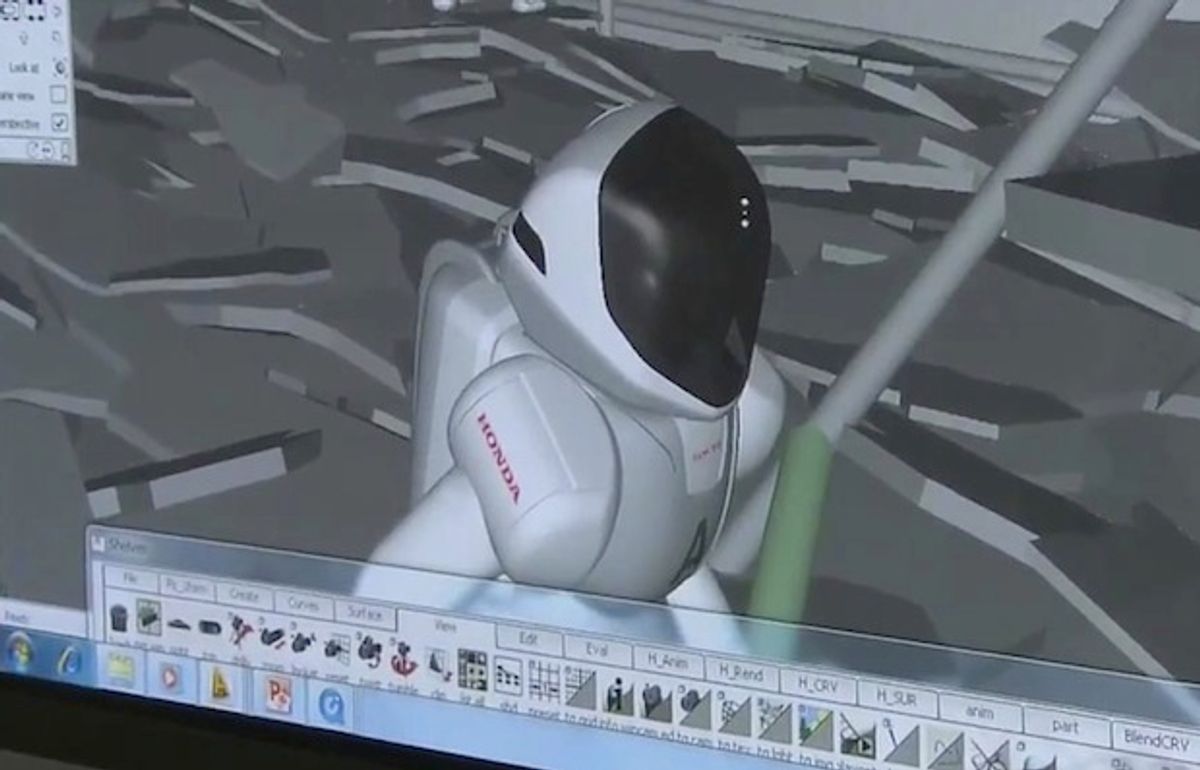Following the March 2011 earthquake and tsunami that crippled Japan's Fukushima nuclear plant, Honda reportedly received numerous requests to send its humanoid robot ASIMO to help with the recovery. ASIMO, however, wasn't designed to work outside a lab or office environment, let alone a highly radioactive rubble-strewn zone. Now it looks like Honda is working to address the problem by developing a bigger, beefed-up version of ASIMO that can walk, crawl, and perform tasks in a disaster environment.
After the Fukushima accident, many observers were surprised that Japan, a country known for its advanced robots, wasn't better prepared and had to rely on U.S. robots instead. In the months that followed, Japanese government agencies and companies got to work to develop capable disaster-response robots. Honda, in particular, developed a tracked vehicle called High-Access Survey Robot, in collaboration with Japanese R&D lab AIST. But it seems the company has something even more interesting in the works.
In a documentary titled "Robot Revolution" that aired earlier this year, Japan's broadcasting company NHK got the inside scoop that Honda is developing a new humanoid specifically for disaster response. From the footage, which shows the robot only as a computer rendering, it appears that the new humanoid will be able to negotiate the wreckage inside a reactor building and operate things like water valves. Here are some screenshots:
We asked Honda for more details, but the company did not immediately respond to our inquiries. The only official information Honda has released related to this topic is the paragraph below, buried in a recent release:
While making progress in the development of ASIMO, a humanoid robot that can be helpful to people while co-existing with people in their daily lives, Honda also has been studying and researching the possibility of using humanoid robots at disaster sites. Following the development of this survey-performing robot arm, Honda will accelerate the development of humanoid robots also designed for use in response to disasters, including the prevention and mitigation of damage caused by a disaster.
If Honda really builds the robot shown in the documentary, this new humanoid will be taller and stronger than ASIMO—and similar to the abandoned prototypes that the company developed in the late 1990s leading up to ASIMO's first unveiling. Those prototypes were deemed too large and intimidating to coexist alongside people, but are the right size for doing work in hazardous environments.
As such, the new initiative will undoubtedly weather comparisons with the DARPA Robotics Challenge (DRC). In fact, we heard that Honda was invited to take part in the DRC but declined to get involved. The company has always stood by its line that the ASIMO project will never be used for any military purposes, so my guess is that the DRC, which is funded by the U.S. Department of Defense, would be off-limits.
This also explains why a group of researchers from the University of Tokyo's JSK lab left to form an independent company, Schaft Inc., to compete in the DRC; the university prohibits military-funded research. This position stands in stark contrast to South Korea's KAIST, which is taking part in the challenge with several American universities. Its HUBO robot is undergoing a serious makeover in the run-up to the competition.
I'm sure Honda's engineers are keenly aware of these and other robots being developed for the challenge, and they probably want to maintain their reputation for building some of the world's most advanced humanoids. It's not just a matter of pride, though that must be a factor. Rather, I suspect Honda wants to prove to the world that all the money and resources it has spent with humanoid technology can be more than a marketing tool and actually help with real-world applications.
One question is whether Honda will develop this new robot alone or seek to team up with another organization. One good candidate—and this is entirely speculative—would be AIST. Besides their recent collaboration on the High-Access Survey Robot, AIST also borrowed Honda's P3 (an ASIMO predecessor) when it began its Humanoid Research Project (HRP) at the turn of the millennium. That project has seen the development of several prototypes designed to someday work alongside people on construction sites, for example. The HRP robots have already shown they can survive falls, stand up from a prone position, crawl, operate tools, and dance like a human. In addition, the AIST team has developed a teleoperated control system that simplifies certain tasks (such as walking with the push of a joystick), so it would make sense that the teams would work together.
Right now it's anyone's guess when we'll get to see Honda's new robot in the flesh. Honda may want to trot out the new robot just in time to steal the DRC's thunder, but they could also wait and see how it pans out to ensure they do it one better. Regardless, it's safe to say we're in for some exciting robot news in the near future.
Watch the full NHK documentary here:








